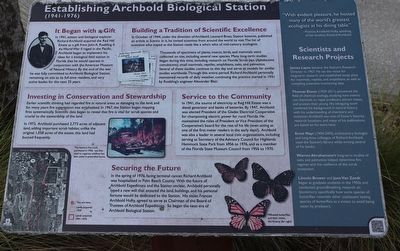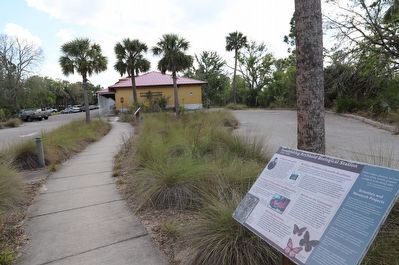Near Venus in Highlands County, Florida — The American South (South Atlantic)
Establishing Archbold Biological Station
(1941-1976)
It Began with a Gift
1941, aviator and biological explorer Richard Archbold acquired the Red Hill Estate as a gift from John A Roebling II. As World War II raged in the Pacific, Archbold began to implement ideas for a biological field station in Florid that he would operate in conjunction with the American Museum Natural History. By the end of the war he was fully committed to Archbold Biological Station, remaining on site as its full-time resident, and very active leader, for the next 35 years.
Investing in Conservation and Stewardship
Earlier scientific thinking had regarded fire in natural areas as damaging to the land, and for many years fire suppression was emphasized. In 1967, the Station began mapping fires systematically. Scientific data began to reveal that fire is vital for scrub species and crucial to the stewardship of the land.
In 1973, Archbold purchased 2,773 acres of adjacent land, adding important scrub habitat; unlike the original 1,058 acres of the estate, this land had burned frequently.
Building a Tradition of Scientific Excellence
October of 1944, under the direction of Archbold, Leonard Brass Station botanist, published an article in Science. In it, he invited scientists from around the world to visit. The list of scientist who stayed at the Station reads like a who’s who of mid-century ecologists.
Thousands of specimens of plants, insects, birds, and mammals were collected on site, including several new species. Many long-term studies began during this time, including research on Florida Scrub-Jays (Aphelocoma coerulescens), small mammals, reptiles, amphibians, oaks, and palmettos. Several of these studies continue to this day and serve as models for similar studies worldwide. Through this entire period, Richard Archbold personally maintained records of daily weather continuing the practice started in 1931 by Robing's engineer Alexander Blair.
Service to the Community
In 1941, the source of electricity at Red Hill Estate was a diesel generator and banks of batteries. By 1947, Archbold was elected President of the Glades Electrical Cooperative for championing electric power for rural Florida. He maintained the roles of President or Vice President of the Cooperative's board for the rest of his life (even acting as one of the first meter readers in the early days!). Archbold was also a leader in several local civic organizations, including serving as Secretary of the Advisory Council for Highlands Hammock State Park from 1956 to 1976, and as a member of the Florida State Museum Council from 1956 to 1970.
Securing the Future
In the spring of 1976, facing terminal cancer Richard Archbold was hospitalized in Palm Beach County. With the future of Archbold Expeditions and the Station unclear, Archbold personally typed a new will that ensured the land, buildings, and his personal fortune would be dedicated to the Station. His sister Frances Archbold Hufty, agreed to serve as Chairman of the Board of Trustees of Archbold Expeditions. So began the next era of Archbold Biological Station.
"With evident pleasure, he hosted many of the world's greatest ecologists at his dining table."
--Frances Archbold Hufty speaking of her brother, Richard Archbold.
Scientists and Research Projects
James Layne became the Station’s Research Director in 1967. He set the vision for long-term research and established study plots for mammals, reptiles, and amphibians, as well as compiling extensive monitoring data.
Thomas Eisner (1929-2011) pioneered the field of chemical ecology, studying who insects use chemicals to repel predators, attracts mates, and protect their young. His intriguing work combined his background in natural history with his understanding of chemistry and evolution. Archbold was one of Eisner's favorite research locations, and many of his publications are based on his work here.
Ernst Mayr (1904-2005) evolutionary biologist and long colleague of Richard Archbold, used the Station’s library while writing several of his books.
Warren Abrahamson's long-term studies of oaks and palmettos helped determine fire regimes and the resilience of the scrub ecosystem.
Lincoln Brower and Jane Van Zandt began as graduate students in the 1950s and conducted groundbreaking research on biomimicry: specifically how some species of butterflies resemble other unpleasant casting species of butterflies as a means to avoid being eaten predators.
Topics. This historical marker is listed in these topic lists: Environment • Horticulture & Forestry • Science & Medicine. A significant historical month for this entry is October 1944.
Location. 27° 10.945′ N, 81° 21.134′ W. Marker is near Venus, Florida, in Highlands County. Marker can be reached from Main Drive west of Old State Route 8, on the left when traveling west. Located at Archbold Biological Station. Touch for map. Marker is at or near this postal address: 123 Main Dr, Venus FL 33960, United States of America. Touch for directions.
Other nearby markers. At least 8 other markers are within 8 miles of this marker, measured as the crow flies. Building on the Legacy of Richard Archbold (a few steps from this marker); The Red Hill Estate (a few steps from this marker); Applying Science to Conservation Action (a few steps from this marker); Archbold Biological Station at Red Hill (within shouting distance of this marker); In Memory of the Challenger Astronauts (approx. 8 miles away); Dedicated to Lake Placid Area Veterans of World War II (approx. 8 miles away); Lastinger Memorial Park (approx. 8 miles away); 1927 Atlantic Coast Line Railroad Depot (approx. 8.1 miles away). Touch for a list and map of all markers in Venus.
Also see . . . Archbold Biological Station. (Submitted on March 27, 2023.)
Credits. This page was last revised on March 27, 2023. It was originally submitted on March 27, 2023, by Dave W of Co, Colorado. This page has been viewed 80 times since then and 13 times this year. Photos: 1, 2. submitted on March 27, 2023, by Dave W of Co, Colorado. • Bernard Fisher was the editor who published this page.

